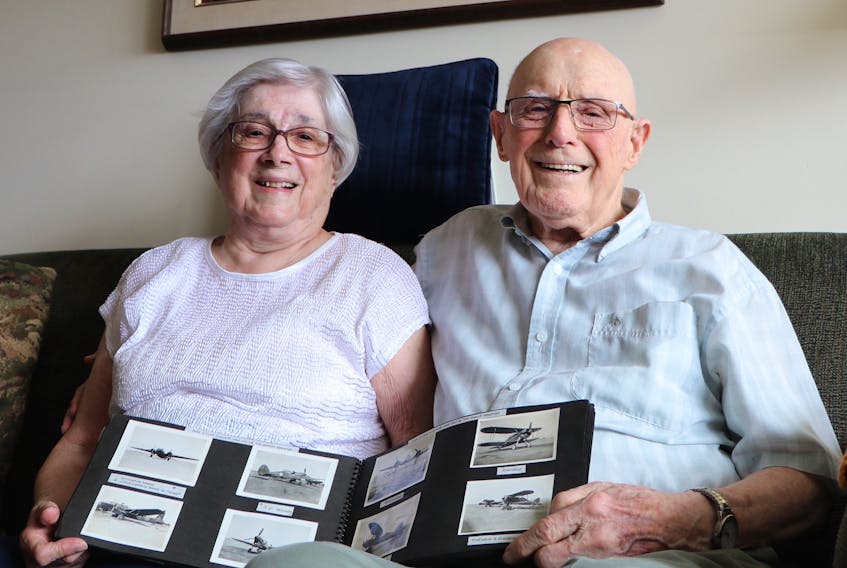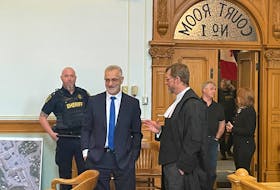ST. JOHN'S, N.L. — He’s 99 now, and the Second World War is three-quarters of a century back in time, but like many veterans of that terrifying period in human history Elmo Baird is still haunted by what he saw and felt, and it often robs him of sleep at night.
Baird becomes emotional and pauses while his fingers brush the skin under his eyes where the tears have slipped after thinking back. The bad memories are loud, they are repetitive and they are deadly real in his mind.

His wife, Eleanor, 96, sits in a chair next to him to provide comfort. The light from the large window behind them offers a calming, soft daylight and the view overlooks a peaceful St. John’s.
“We won’t go there,” he said quietly, after being asked about specific incidents from the war.
He then readjusts himself in his chair and apologizes for becoming emotional.
His attention turns to an old black photo album on a small table in front of him. He flips the rectangular cover and reveals a treasure of small black-and-white photographs attached to the pages inside.
Few people have seen them.
Regular soldiers and airmen were not permitted to carry cameras during the Second World War, but Baird had purchased a small camera while in Britain which he kept hidden in his pants.
Throughout his movements over the next few years with the Royal Air Force in Europe and the Middle East, he captured magnificent images — everything from burning downed German planes, to ships on which he travelled through U-boat infested waters, to the pyramids of Egypt and camels in the Sahara desert — and snippets of daily life of ordinary people in Iraq and Egypt.
Some of the photos are so alluring they are like a still taken from an old black-and-white movie.
In addition to those he took, there are some photos in his collection that he purchased in one country or another, or took possession of after they were confiscated from a German prisoner.
“Those pictures came from a German prisoner,” he said, pointing to a couple of images that include pictures of German general Erwin Rommel and German paratroopers.
“The boys would take the prisoners to a prisoner of war camp and, of course, they searched them all to see what they had on them, because they could have something they could turn against you.”

Among the collection, Baird’s hand pauses over a photo of a makeshift grave near a desert road. It’s where a downed Canadian pilot was buried by the Germans. Years ago, Baird tried to track down the pilot’s family, but had no luck.
Turning another page, a smile lights up his face. There are photos of happier moments as members of his unit have a tug-of-war and a chariot race, one soldier wearing a lady’s bra.
The images fire his memory as he scans through them, and he smiles and describes where each was taken.
Enlistment
Baird didn’t start out with the Royal Air Force.
On Dec. 8, 1939, he had just returned to his home in Twillingate from a logging camp near Pacquet on the Baie Verte Peninsula when he learned loggers were being sought for forestry unit service in Great Britain. He enlisted the next day and his journey to England began.
He worked at a number of different logging camps in Britain producing timber needed for coastal defence. But he developed the urge to do more, Baird said.
“A fellow Newfoundland logger, Bert Downey from Doyles in the Codroy Valley, and I both felt we could do more by joining one of Britain’s military forces,” Baird said. “So in March 1941 we went to Edinburgh to enlist in the Royal Air Force.”
Baird was trained as an aircraft mechanic.
He sailed across the Indian Ocean and through the Persian Gulf on troopships as his group attached to different army units at various locations.

One of the ships he was on, HMS Empress of Japan (after Japan entered the war, the ship was renamed the Empress of Scotland) was commanded by Capt. John Wallace Thomas from Harbour Le Cou, Newfoundland.
While crossing the Indian Ocean, Baird said, the long voyage and fear of attack got to one man.
“One of our airmen revealed his anguish by jumping over the ship’s rail and committed suicide,” Baird recalled. “This caused a two- to three-hour delay as we searched for him, but we had to continue on without him.”
Eventually, Baird and his unit were stationed at a desert camp at Shaibah, about 18 miles north of Basra, Iraq.
“On one of our excursions deep into the desert to rescue the pilot of a downed Hurricane aircraft, we inadvertently crossed the border into Saudi Arabia, where we were detained overnight in a Saudi jail,” he said. “It was the closest I came to being a prisoner of war.”
On the troopship that transported them, there was a photographic unit, and members of it would develop his film, Baird said. He’d place the photos in a cigarette tin that he carried throughout the war.
Some of his photos were damaged or destroyed by sweat soaking from his body in the desert heat.

The cigarette can eventually made it back with him to Newfoundland.
His daughter, Margaret O’Dea, said that, as young children, she and her siblings would open the cigarette tin to look at the photos.
“We’d untie the string and we’d all be there looking through the photos and say, ‘Dad, Dad, what’s this?’ and he’d always give us some silly answer,” she said. “There’s one picture there … they buried a German airman, and next to his cross they stuck his rifle with a helmet stuck on it. I remember Dad telling me one Sunday that’s how trees grew in the desert.”
“Guilty your honour,” Baird said with a laugh.
He said that at the time he didn’t want to talk about his war experiences with his children.
Outside of family members and friends, few people have seen Baird’s photo collection.
They’ve been loaned at times during the years to a school class as part of a Remembrance Day exhibit, and recently he allowed them to be displayed at a ceremony marking the 75th anniversary of D-Day.
Sailing home
In mid-December 1945, after the war in Europe was over, Baird was sent to a base in Cheltenham where a “few hundred Newfoundlanders” were being gathered to be sent home.
“I spotted Jim Anstey from Twillingate, who sailed overseas with me, but hadn’t seen him in the six years in between,” he said. “We sailed from Liverpool around Dec. 23, 1945 and spent Christmas at sea. It was quite rough. The table we were using was torn from the bulkhead and Christmas dinners were spread over the deck.”
When they arrived in St. John’s on Dec. 30, Eleanor was waiting for him.
“The biggest surprise was meeting this young lady with whom I had been corresponding for the previous six years, Eleanor Gillett,” he said, looking at his wife.
“I started to look forward to getting home, for one main reason and she became the guiding light of my life.”









